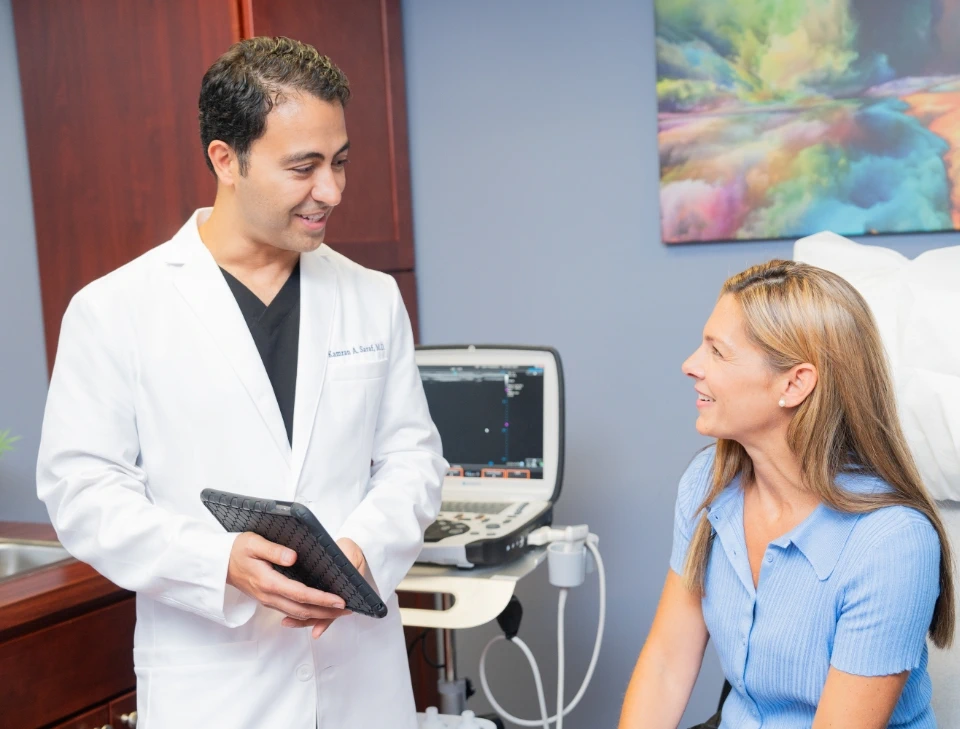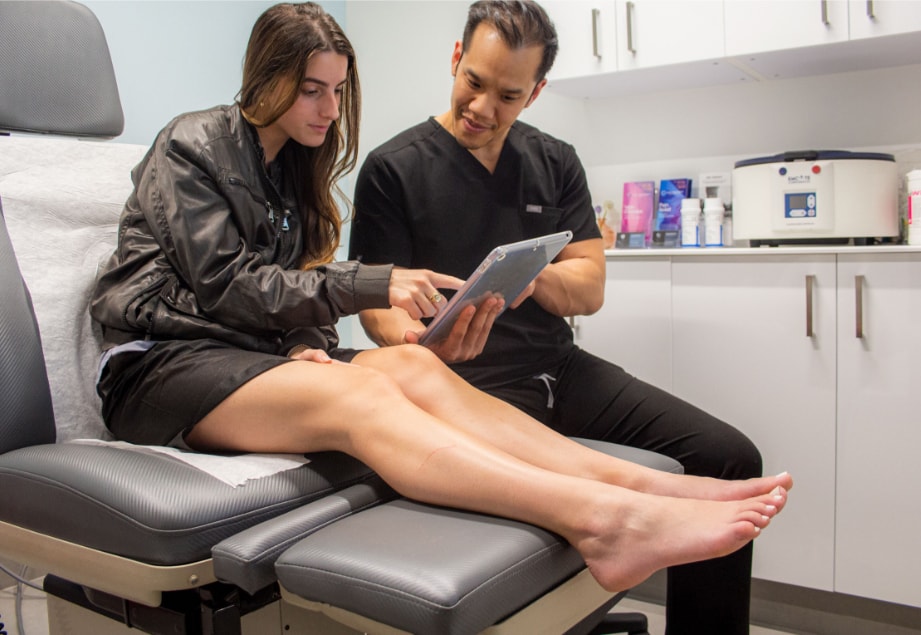What is a damaged vein?
The human body has two types of blood vessels — arteries and veins. The arteries carry oxygenated blood from the heart to various parts of the body, and the veins carry deoxygenated blood back to the heart. When you have a damaged vein, one of the blood vessels responsible for carrying blood to your heart is malfunctioning or damaged, incapable of performing its essential tasks. However, “vein damage” isn’t an official medical term — it’s a casual term that can encapsulate a wide range of vascular conditions, such as spider veins, varicose veins, deep vein thrombosis, and chronic venous insufficiency.

Chronic venous insufficiency: the root cause of damaged/ diseased veins
Chronic venous insufficiency is the primary root cause of most vein problems and vein damage. Venous insufficiency is a circulatory disorder caused by the collapse of vein valves. In healthy veins, the valves act as one-way doors to facilitate optimal blood circulation towards the heart, often against the force of gravity. When the vein valves collapse or malfunction, blood flows backward because of gravity and accumulates in the leg veins, eventually leading to vascular dilation and the formation of spider veins and varicose veins. The collapse of vein valves is the root cause of most vein damage and diseases.
Symptoms of chronic venous insufficiency:
- Leg heaviness
- Frequent leg cramps
- Restless leg syndrome
- Leg pain
- Leg swelling
- Spider veins
- Varicose veins
- Skin discoloration

The earliest signs and symptoms of chronic venous insufficiency are fairly mild, such as leg swelling, frequent leg cramps, restless leg syndrome, and leg pain. Most people attribute these symptoms to aging, exhaustion, or other problems and avoid consulting vein doctors. However, if these symptoms worsen at the end of the day or after long periods of sitting or standing still, that’s a pretty strong indication that you have underlying vein disease. The symptoms of vein disease worsen when more blood accumulates in the leg veins, which happens when you sit or stand still for long periods of time.
Most people contact vein doctors when they first notice spider veins or varicose veins. Spider veins are dense clusters of reddish or bluish blood vessels that appear in a web-like form on the skin’s surface. They gradually spread outwards from a central location. Varicose veins are dense blood vessels that bulge out of the skin’s surface in a twisted, tangled, and knotted form, often resembling twisted branches or ropes. They bulge out of the skin’s surface and are indicative of advanced chronic venous insufficiency. If you notice any of the signs or symptoms of chronic venous insufficiency, please contact a reliable vein doctor near your location.
What happens if varicose veins are left untreated?
Varicose veins and broken capillaries on legs continue spreading and growing with time. If you don’t seek treatment for the damaged valves in your veins or the veins popping out on the legs, the varicose veins will continue expanding. As more blood accumulates in the leg veins, the varicose veins will grow larger and more prominent, eventually filling up with excess blood. Over time, the walls of the veins will weaken and become prone to bursting, leading to profuse bleeding. When your varicose veins burst, you have to be taken to an emergency room.
Burst varicose veins aren’t the only possible complication of untreated chronic venous insufficiency. Over time, you will experience skin discoloration in your legs because of the lack of effective blood flow and circulation. Without sufficient blood flow, the wounds in your legs won’t heal properly, leading to non-healing wounds, also known as leg ulcers. Furthermore, the accumulated blood in your leg veins may turn into blood clots that can eventually break away and travel to the lungs, leading to a potentially fatal pulmonary embolism. Deep vein thrombosis is one of the most dangerous complications of untreated vein disease.
What are the best treatments for chronic venous insufficiency?
If you have engorged veins, varicose veins, or thick veins that don’t go away, you need minimally invasive treatments for chronic venous insufficiency. When you contact a reliable vein treatment clinic, you can expect a thorough consultation and evaluation. The vein doctor will administer duplex ultrasound tests to visualize the blood flow in your leg veins and curate a personalized vein treatment plan for you. Minimally invasive vein treatments are safe, in-office procedures that conclude within an hour with no downtime. Below, we describe some of the best treatments for chronic venous insufficiency.
Radiofrequency Ablation
Radiofrequency ablation is a minimally invasive treatment for chronic venous insufficiency. The vein doctor makes a small incision on the skin’s surface to insert a catheter that channels thermal energy to destroy the diseased saphenous vein. The accumulated blood reroutes into healthier leg veins and restores optimal blood circulation to the heart.
Laser Ablation
Laser ablation is a minimally invasive treatment for chronic venous insufficiency. The vein doctor makes a small incision on the skin’s surface to insert a laser fiber that channels laser energy to collapse the problematic vein. The accumulated blood reroutes into healthier leg veins and restores optimal blood circulation to the heart.
VenaSeal
The vein doctor injects a medical-grade vein glue into the diseased saphenous vein to seal its walls shut. The diseased vein essentially becomes a hardened scar tissue eventually metabolized by the body. The accumulated blood reroutes into healthier leg veins to restore optimal blood circulation to the heart.
Ambulatory Phlebectomy
Ambulatory phlebectomy is one of the best treatments for superficial varicose veins. The vein doctor physically extracts the unwanted varicose veins through small incisions on the skin’s surface. The incision marks gradually heal and fade away.
Sclerotherapy
Sclerotherapy is a minimally invasive treatment for spider veins. The vein doctor injects a sclerosant medicine into the spider veins to make them shrink and fade away from the skin’s surface. The spider veins turn into hardened scar tissues eventually metabolized by the body.









